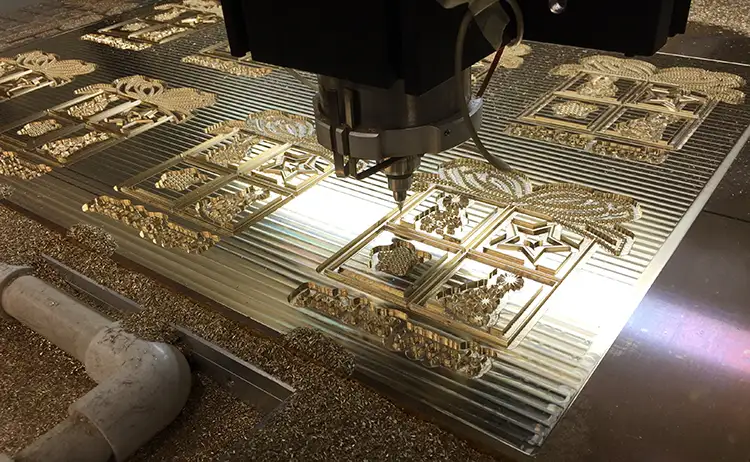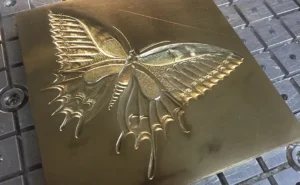
Machine technology maximizes detail, eliminates chemicals.
By Hallie Forcinio, writer, PostPress
Computer numerical control (CNC) engraving is a process where a computer-controlled cutting tool is used to remove material from a workpiece to create a desired shape or pattern. This process has been around for several decades and has been widely used in the automotive, aerospace and manufacturing industries.
Advancements in technology have led to significant improvements in CNC machines and software, increasing the precision of the engraving process and helping to expand use of the technology for engraving sculpted embossing, combination foil embossing and foiling dies. The CNC machine can perform 100% of the engraving, although some dies still may be produced in a hybrid process that combines CNC engraving with hand finishing.
“The precision of modern CNC machines is measured in microns, allowing for extremely fine detail and accurate reproduction of designs,” said Christopher Arns, director of sales at H+M USA, a KURZ company, a supplier of hot-stamping and coating technology located in Charlotte, North Carolina. He explained, “This precision results in sharper and more accurate images with less ‘bridging’ or ‘flaking.’ This is particularly important in the decorating industry, where high-quality images and intricate designs are essential.”
Precise reproduction plus the sustainable nature of the technology will boost adoption of CNC engraving for the production of foil stamping and embossing dies, predicted Robert Murphy, vice president of sales and marketing at DATRON Dynamics, Inc., a supplier of CNC machines located in Milford, New Hampshire. The supplier is working with companies that want to bring engraving capability in-house.
Successful CNC engraving
Successful engraving depends on properly prepared artwork. “The three most important items needed for a quality CNC die are artwork, artwork and artwork! High-quality, 100% black and white vector art is crucial to creating a great die,” stated Doug Pendergast, national account director at Owosso Graphic Arts, Inc. Based in Owosso, Michigan, the photoengraver has been in business since 1949 and offers magnesium, brass and copper dies.
Engravers need to know all facets of a project, but first, and perhaps foremost, they must understand what substrate the die will encounter. “This will help ensure the correct depth and design is achieved for the specific application,” explained Arns.
In addition, “… clear communication with your engraver is critical,” said Ross Hutchison, president of Universal Engraving, Inc. and national sales manager of Infinity Foils, Inc., both part of the UEI® Group Companies, a supplier of foil stamping and embossing products in Overland Park, Kansas.
“Important details include the type of engraved die or tool needed, registration requirements, heat comp, press information, the number of dies needed, turnaround time, expectations, engraving perspective and finished intent, to name a few,” Hutchison continued.
When implementing CNC engraving, another consideration is identifying the right people to process the digital artwork and learning the best practices associated with operating the machine. “When purchasing CNC engraving equipment, it’s important to make sure it comes with proper training so die production can begin right away,” Murphy said.
Growth of CNC Technology

CNC-engraved dies offer a sustainability benefit by eliminating the need for chemical etching and related environmental issues. “Engraving dies on a CNC machine is a cleaner process,” commented Murphy.
However, companies that decide to transition to CNC engraving should be aware they may need to install multiple CNC machines to achieve the same output as their chem-etch lines, which typically offer high-volume production.
The type of engraving and number of dies will help determine if CNC is the correct choice. There are many benefits to CNC, but the costs involved with the machinery, software and trained operators also must be a part of the equation. It is not the answer for all engraving applications.
Today’s CNC machines are more accurate and rigid and sometimes include integrated vacuum tables to hold stock material. In addition, cycle times are faster and, in many instances, CNC machines occupy a smaller footprint as well.
“The use of high-speed spindles, more powerful motors, advanced cutting tools and improved milling programs/strategies have significantly increased the speed of the engraving process,” Arns said. He added, “This increased speed reduces lead times and production costs significantly, which is particularly important in the graphic industry, where turnaround times are critical. With the ability to program and store designs digitally, CNC machines quickly can reproduce designs with a high degree of accuracy and consistency, reducing the likelihood of errors and ensuring that each product meets the same high-quality standards.”
“These features are vitally important to efficient production of quality dies,” agreed Murphy. Automated processes like an operator interface, which works like a smartphone, and control improvements using software simplify operation and provide step-by-step instructions for job setup and machine operation. Built-in safety features make the systems safe for virtually anyone to run.
“It takes three days of training to learn how to set up and run dies. Skilled machinists, who are difficult to find, are no longer required,” Murphy said.
At the front end, CAD/CAM systems used to process artwork and generate “tool paths” for a CNC engraver have become more powerful and easier to use, another time and cost saver. An array of engraving bits is available to achieve different effects. Bits can be resharpened multiple times and are inexpensive to replace when worn out.
Die materials and designs
Brass, copper and magnesium can be engraved on a CNC machine. However, brass is the most common metal for most engraving applications.
“Brass is a durable material and very easy to engrave. Brass can be engraved ‘dry,’ which means no coolant or lubricant is required,” Murphy said. “The brass chips generated by the engraving process can be vacuumed out of the machine using a shop vac and then recycled.”
Magnesium can withstand high temperatures and is impact resistant, which yields a long-lasting die. “Magnesium is used for embossing and combination dies instead of brass in some situations,” said Pendergast.
“CNCs can be used with any type of engraved die,” said Hutchison. “It is an operational decision that each engraver has to make – some engravers use only CNC equipment, and others don’t use it at all. We are a hybrid and have developed operational procedures that help us to determine which method of manufacturing is best for each order.”
Recent developments that rely on CNC engraving include new refractive MicroEmboss and NanoEmboss technology, which creates extremely fine patterns on the stamping die surface. Capable of adding a unique landscape of reflections, depth and dimension to the design, this technology is particularly well-suited for high-end packaging, luxury goods, cosmetic products and security applications. NanoEmboss and MicroEmboss dies do not require a fiberglass counter die and can be combined with emboss and combination dies. “The latest advancements allow MicroEmboss and NanoEmboss technology to be applied on cold foil,” noted Arns.
New technology advances have moved the art of CNC engraving forward, working with traditional engraving processes to offer more choice for those using dies to decorate print. Historically utilized in automotive, aerospace and manufacturing applications, it’s making itself known in die production for print and packaging.

